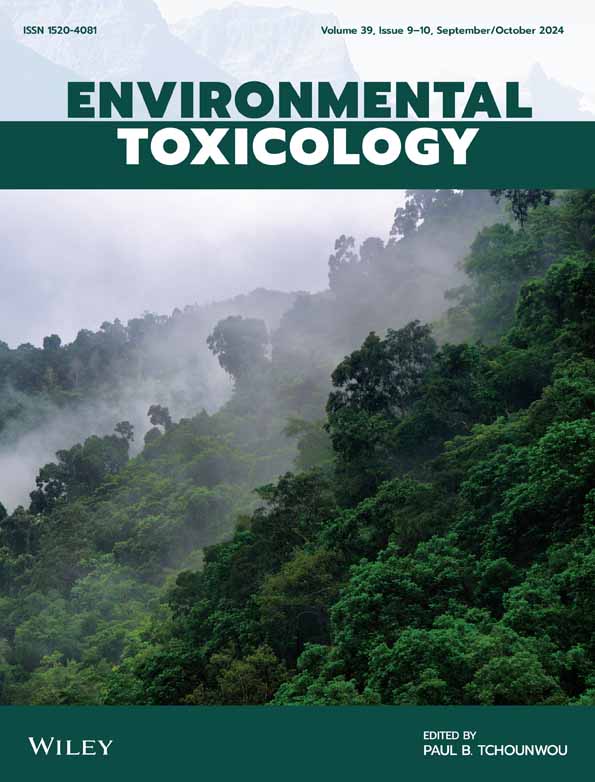Mono(2-Ethylhexyl) Phthalate Induces Inflammatory and Angiogenic Alterations Mediated by the PI3K/AKT Pathway in HTR-8/SVneo Trophoblastic Cells.
IF 3.2
3区 医学
Q2 ENVIRONMENTAL SCIENCES
引用次数: 0
Abstract
Exposure to mono(2-ethylhexyl) phthalate (MEHP) during pregnancy has been associated with adverse pregnancy and birth outcomes characterized by extravillous trophoblast (EVT) abnormal function. Previous reports have suggested that MEHP can activate the PI3K/AKT pathway in EVT cells, a pathway known to regulate inflammation and angiogenesis in these cells. However, the molecular effects of MEHP on crucial EVT functions such as inflammatory and angiogenic homeostasis remain unexplored. This study aimed to characterize the role of the PI3K/AKT pathway as a mechanism of action of MEHP activity, as well as its effects on inflammatory and angiogenic soluble molecules in HTR-8/Svneo EVT human-derived cells. The results showed that a low (5 μM) MEHP concentration increased AKT phosphorylation, but a high (200 μM) concentration did not. Conversely, a high MEHP concentration, but not a low concentration, promoted nuclear translocation of p65 in a PI3K-dependent manner. Notably, distinct patterns of cytokines were transcriptionally and secretorily activated by high and low concentrations of MEHP. IL1B, CXCL8, and TNF were transcriptionally upregulated by MEHP 5 μM, while gene expression and secretion of IL-6 were induced by MEHP 200 μM, suggesting a biphasic inflammatory dose response. In addition, both MEHP concentrations upregulated the expression of angiogenic molecules (VEGF, PGF, and ANGPTL4) and impaired migration and tube formation in HTR-8/Svneo cells. Both inflammatory and angiogenic responses induced by MEHP were inhibited by the PI3K inhibitor LY294002. Collectively, these data demonstrate that MEHP induces inflammation and impairs angiogenesis partly via PI3K/AKT in HTR-8/SVneo cells. These findings may help to understand previous clinical associations between MEHP exposure and placental pathophysiology.邻苯二甲酸单(2-乙基己基)酯通过PI3K/AKT通路诱导HTR-8/SVneo滋养细胞炎症和血管生成改变
妊娠期间暴露于邻苯二甲酸单(2-乙基己基)酯(MEHP)与不良妊娠和以胞外滋养细胞(EVT)功能异常为特征的分娩结局有关。先前的报道表明,MEHP可以激活EVT细胞中的PI3K/AKT通路,这是一种已知的调节EVT细胞炎症和血管生成的通路。然而,MEHP对EVT关键功能(如炎症和血管生成稳态)的分子作用仍未被探索。本研究旨在表征PI3K/AKT通路作为MEHP活性的作用机制,以及其对HTR-8/Svneo EVT人源性细胞中炎症和血管生成可溶性分子的影响。结果表明,低浓度(5 μM) MEHP可提高AKT的磷酸化水平,而高浓度(200 μM) MEHP则无此作用。相反,高MEHP浓度,而不是低MEHP浓度,以依赖pi3k的方式促进p65的核易位。值得注意的是,不同的细胞因子模式被高浓度和低浓度的MEHP转录和分泌激活。MEHP 5 μM可上调il - 1b、CXCL8和TNF的转录水平,而MEHP 200 μM可诱导IL-6的基因表达和分泌,提示两期炎症剂量反应。此外,两种MEHP浓度都上调了HTR-8/Svneo细胞中血管生成分子(VEGF、PGF和ANGPTL4)的表达,并损害了细胞的迁移和管形成。MEHP诱导的炎症反应和血管生成反应均被PI3K抑制剂LY294002抑制。综上所述,这些数据表明MEHP在HTR-8/SVneo细胞中部分通过PI3K/AKT诱导炎症并损害血管生成。这些发现可能有助于理解先前MEHP暴露与胎盘病理生理之间的临床关联。
本文章由计算机程序翻译,如有差异,请以英文原文为准。
求助全文
约1分钟内获得全文
求助全文
来源期刊

Environmental Toxicology
环境科学-毒理学
CiteScore
7.10
自引率
8.90%
发文量
261
审稿时长
4.5 months
期刊介绍:
The journal publishes in the areas of toxicity and toxicology of environmental pollutants in air, dust, sediment, soil and water, and natural toxins in the environment.Of particular interest are:
Toxic or biologically disruptive impacts of anthropogenic chemicals such as pharmaceuticals, industrial organics, agricultural chemicals, and by-products such as chlorinated compounds from water disinfection and waste incineration;
Natural toxins and their impacts;
Biotransformation and metabolism of toxigenic compounds, food chains for toxin accumulation or biodegradation;
Assays of toxicity, endocrine disruption, mutagenicity, carcinogenicity, ecosystem impact and health hazard;
Environmental and public health risk assessment, environmental guidelines, environmental policy for toxicants.
 求助内容:
求助内容: 应助结果提醒方式:
应助结果提醒方式:


